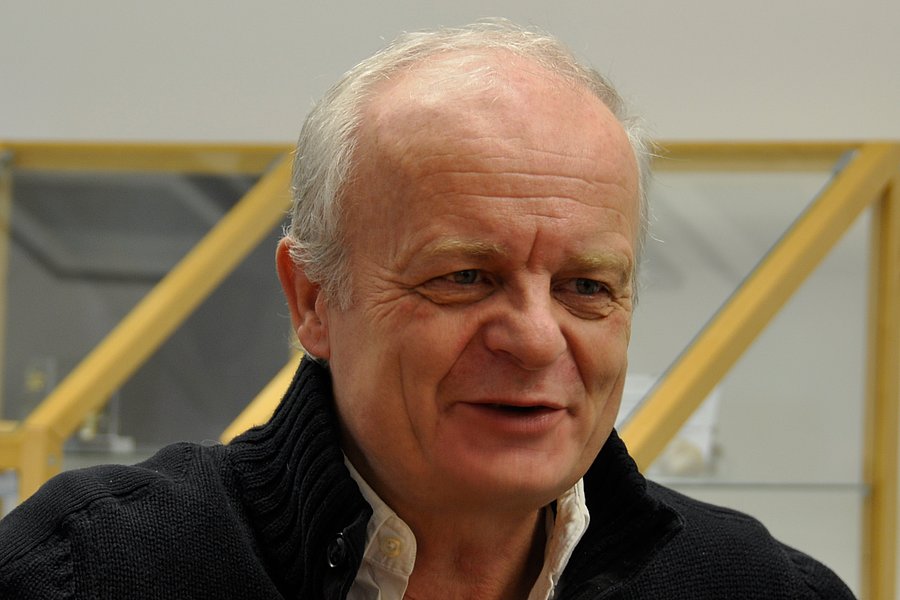
Prof. Dr. Dr. Dr.h.c. Dieter Vieweger / Biblisch-Archäologisches Institut
Foto: UniService Transfer
The man who found Golgotha
Prof. Dr. Dr. h.c.. Dieter Vieweger and the Biblical-Archaeological Institute of the University of Wuppertal.
He is one of the most renowned German scholars in the Holy Land. Three months a year he works in Wuppertal: Prof. Dr. Dr. h.c. Dieter Vieweger. Here he directs the Biblical-Archaeological Institute of the Bergische Universität, and in parallel teaches the subjects Old Testament and Biblical Archaeology at the Kirchliche Hochschule Wuppertal/Bethel, as well as Archaeology at the private University of Witten-Herdecke. "That is perhaps quite surprising," he says, "at the Kirchliche Hochschule I teach almost only theology, that is, Old Testament, and that is because Biblical Archaeology plays a subordinate role there. In Witten-Herdecke I devote myself much more to archaeological questions, as well as to the explosive current problems: 'Who owns the Holy Land?', 'From the Arab Spring to the Autumn of Disappointment', or: 'What will become of Syria - who is acting how in the Syrian civil war?'" Three quarters of the year, however, the Karl-Marx-Stadt-born scientist is engaged in pure archaeology; and in the heart of Jerusalem, in Tiberias on the Sea of Galilee and in northwestern Jordan.
Difficult start to his career in the former GDR
Dieter Vieweger, now 61, would never have thought it possible that he would ever work outside the GDR. "I was kicked out of school at 16 for political reasons. After that, everything was very difficult. I didn't get any training, not even vocational training as a 'brewer and maltster' in the small brewery in my home village in the Ore Mountains," he recounts freely. During this time, he says, the Protestant Church picked him up and made it possible for him to receive a school education similar to a high school diploma in Moritzburg. "It was a `church Abitur,'" he reports, adding with a smile, "I later got my official, state Abitur as well. In 1992, the Saxon Minister of Education wrote to me that I now had an Abitur. By that time, I was already a professor at Humboldt University in Berlin." Vieweger had studied theology at a church college in Leipzig. "I was not allowed to study at a state university, and of course the church university did not have the right to award doctorates. However, my professor passed my thesis on to a colleague at the Karl Marx University in Leipzig. The only day I ever spent in a university building in the GDR was my doctorate - and no one noticed!" His habilitation turned out to be even more difficult, which he got without a venia legendi (teaching license) "because, after all, the GDR was convinced that people like me wouldn't do socialism any good (you were right!)." With that, he enters 1989."
From parish ministry to Humboldt University
Vieweger first worked as a pastor with Leipzig's famous St. Thomas Boys Choir, a job that fulfilled him. "It was a wonderful job. I organized church classes for the children and young people and camps in the summer - all that came easily to me and gave me the satisfaction of doing meaningful things in the GDR." After the fall of the Wall, he was appointed to the Humboldt University. And then something happened that gave his life yet another completely different turn. The theologian, who examined Bible texts and questioned sagas and legends about their historical core, wanted to know more about their origins: "What is there really to these old tales? Isn't it just a big book of fairy tales after all?" Questions that can only be answered by incorporating ancient history and archaeology in addition to textual research, and preferably by working in the field. "And then I consistently tackled a few things," he explains. "If I want to work in the Holy Land, I have to learn 'regular archaeology' first. I enrolled at the University of Frankfurt and studied pre- and early history. - Like any student, I took notes on every paper and sat in every proseminar."
A different approach to biblical-archaeological research
Vieweger took up archaeology studies at age 34. At 40, he earns a doctorate on a Middle Bronze Age cemetery in Cyprus. Teaching on the one hand and learning on the other "was very interesting to me," he explains, "and it also changed the way I teach significantly." Vieweger is breaking new ground in getting to the bottom of the world of the Bible. "I wanted to find a basis for understanding these times and narratives alongside the biblical texts," he says, "and then I started digging." Starting at the Biblical Archaeological Institute of the University of Berg, he began excavating at a tell in northern Jordan in 2001.
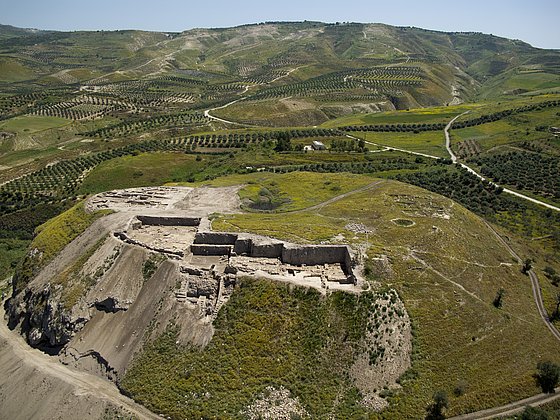
The Tall Zirāʿa
"We chose a hill with a 30-meter layer of rubble, which is 5.6 hectares in size. There are about 35 cities layered on top of each other. This is called a tell. We find the Middle Ages at the top and get down to the middle of the 4th millennium B.C.," he says, briefly describing the process. Since this mountain was a settlement mound with a spring, the scientist enthuses, the location of the city remained preserved and populated through all times. "Because there this spring provided fresh water, people at all times used the tell as a place to live. This means that today we find the entire cultural history of the Orient on this one mountain. That is very rare." In 18 campaigns, or individual excavation periods, Vieweger's 70-member team researched through the entire ancient history between 2001 and 2011. "From the time when people first founded cities in the first place, in the middle of the 4th millennium, to where the Old Testament cities are located (1st millennium B.C.), the Persian, Hellenistic, even Roman (New Testament) settlements through the Byzantine era to the Middle Ages," he says, evidence of the great cultural history of the Orient can be found. The busy scientist has even written a children's book about the secret of this tell. He compares the layering of the cities with a spaghetti ice cream, through which you have to dig your way over chocolate sprinkles, red sauce to cream and vanilla ice cream.
Today, Vieweger can tell with a smile about his eagerness to discover, which is above all, although anyone can easily see the strain behind it: "In the beginning, we drove from Wuppertal to Amman (and back) in a VW bus, because we had no fixed base in Jordan and had to take all the excavation equipment with us, including the bulky equipment for the geophysics. The record was three days and four hours. One driving, one keeping the driver awake, and one sleeping. I did that five times," he laughs, "and then I had the enormous luck of getting in touch with the institute in Jerusalem and Amman. They needed a new director there - and now I've been there for 15 years."
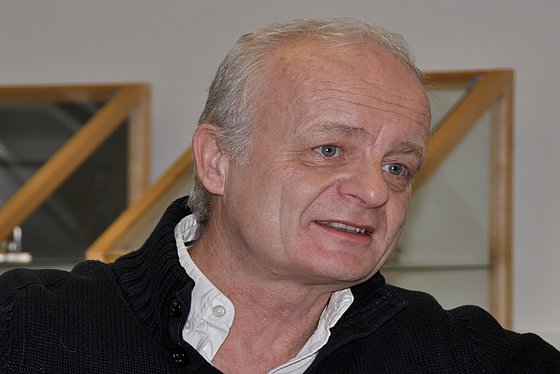
Executive Director for Ancient Studies of the Holy Land
Since 2005, Dieter Vieweger has been the director of the institutes of the German Protestant Institute for Ancient Studies of the Holy Land in Jerusalem and Amman. "This was one of the greatest strokes of luck of my life," says Vieweger, whose institute dates back to an initiative of Kaiser Wilhelm II in 1898. Based on the assumption that the city wall of Jerusalem from the time of Herod the Great (40 - 4 B.C.) could be found under the Church of the Redeemer, which was inaugurated by the German emperor, the latter founded the institute in the hope of assigning the city of Jesus and the rock Golgotha via archaeological finds. "That was then - archaeologically seen - unfortunately all wrong," Vieweger explains. "Here, one had made desire the father of knowledge." Vieweger does not want that under any circumstances and says firmly, "When I dig in the Holy Land, I cannot make my ideas the goal of my research. The tourists and also the pilgrims don't want to be lied to and the scientists certainly not." Scientific misjudgments abound and lead people to distrust biblical archaeology, he emphasizes. In the meantime, the institute was even on the verge of closure. However, the Evangelical Church of Germany gave Vieweger the opportunity to emphasize the importance of this institution, which he finally succeeded in doing. In the meantime, 15 employees* work in Jerusalem and Amman. "It is the one culture on this side and the other side of the Jordan River - that we are excavating together," he continues. He is also proud of the fact that his institute is the only institution to hold valid excavation licenses in both Jordan and Jerusalem. "Next year, we will even excavate in the Palestinian administration's 'A' area. That is possible under international law," he explains. He had to fight a long time for this excavation, because the Palestinians, according to their directive called 'anti-normalization', did not want to accept anyone as a partner who also cooperates in parallel with the Israelis. Vieweger's stance is clear on this. "I can't take sides, otherwise I've lost in the long-running conflict. I work with all scientists, but I will not exclude anyone. And if that doesn't work, then I'll just wait 15 years. I have time, I can wait." Now, finally, he may also begin an excavation with the Palestinians near Bethlehem, possibly where the aqueducts to Jerusalem took their water - that is, in the city's 'waterworks,' so to speak.
The institute has evolved and has now become a grandiose institution. "We were evaluated by the Israel Antiquities Authority two years ago. Like the American Albright Institute, we have been given equal status to the universities there. In Amman, our institute has also been recognized by the state. As a Protestant institution, we are a state-recognized institute in an Islamic country. And the university base in Wuppertal also helps us to do this."
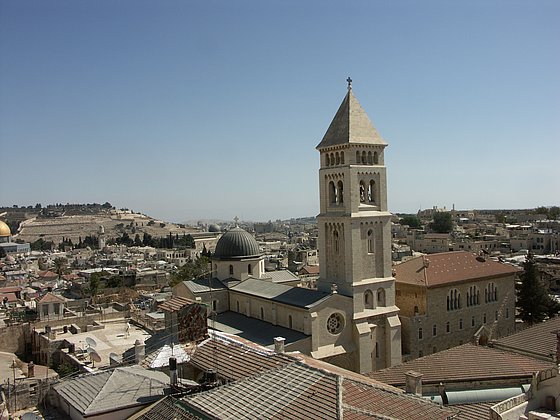
The Biblical-Archaeological Institute in Wuppertal
Vieweger finds the basis, the anchor or the backing for all his activities in the Holy Land in the Biblical-Archaeological Institute in Wuppertal. This is where the urgently needed third-party funds and donations come together, amounting to about one million euros a year. "This money has to be managed transparently, it is accounted for and audited annually," he explains. At the same time, of course, it also enables training and qualification measures. "We have a right to award doctorates here within the Faculty of Humanities and Cultural Studies at the University of Berg, and within this framework we can launch postdoctoral degrees ourselves. This is all very collegial and great. And in this way we can also offer our students a future. Students from Amman or Jerusalem could also do their degrees here."
Vieweger maintains contacts with the surrounding universities, contacts foundations and consults with specialist colleagues at the German Archaeological Institute. "After three months, I then fly back home to Jerusalem."
Golgotha lies beneath the Church of the Holy Sepulchre
Back home, Vieweger made the discovery that will be in future textbooks. When asked about the most exciting discoveries in Jerusalem, he says, "Beneath the Church of the Redeemer, in the middle of the Old City of Jerusalem, lies a giant treasure: Golgotha."
Vieweger and his team resumed old excavation work next to the Church of the Holy Sepulcher. An old license and quite a few difficult permits allowed him to work directly under the Church of the Redeemer. "We excavated right under the church, because it's on 20 pillars. And we found something there that I never thought possible" he tells enthusiastically: a quarry from Herod the Great's times, a Byzantine marketplace - which wrapped around the Church of the Holy Sepulchre - and an absolutely strong evidence of the elongated stone mound Golgotha described by ancient sources."
But one must be careful: "Archaeology cannot prove narratives, cannot substantiate events - we find only mute witnesses of a bygone era. The rock in front of the city - which the New Testament narratives of the crucifixion also presuppose - is clearly attested in the excavation - nothing more."
"Jerusalem is a difficult city for tourists and pilgrims to understand: they think they are passing through the Old City gates and are in the ancient city. Far from it. Originally founded nearly 4000 years ago, the city is now located outside, south of the Old City. Over time, Jerusalem 'grew' further and further north during new foundations after wars or earthquakes. The present Old City wall was built only in modern times - in the 16th century. But since each generation of Jewish, Christian and Muslim pilgrims wanted to find all their traditions in their respective Jerusalem, the guides and monks of all times, 'grew' all the places of memory into their present city without any problems. Thus, the Tomb of David was created in a medieval church and the Via dolorosa in an area still outside Jerusalem at the time of Jesus ... Almost all such subsequently named places have come to their place without any attachment to history. Alone with the Haram ash-Sharif (Temple Mount) one finds the walling of the former temple complex of Herod the Great and near the Church of the Redeemer the Mount Golgotha. All but deeply, deeply buried - 14 meters below the Church of the Redeemer and 17 meters below the present level of the Wailing Wall, the Western Wall."
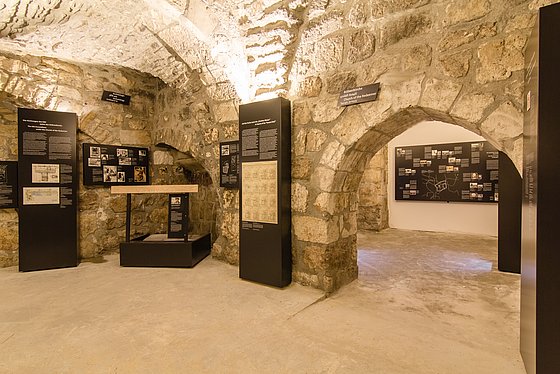
Excavations on the Temple Mount are forbidden
Conrad Schick, Vieweger's predecessor in Jerusalem when the institute was in the process of being founded, was the last person allowed to dig on the Temple Mount. "Schick had a great aura in Jerusalem." Vieweger knows the futility of new excavation licenses on the Temple Mount and instead evaluates Schick's old research with his collaborators*. "We want to still be there in 100 years. That's why I limit myself to what's feasible, and there's so much to explore. After all, we are in a transit corridor between Africa and Eurasia. Throughout the ages, trade routes between Egypt and Mesopotamia carried people and trade goods, ideas and craftsmen, armies and marauders across the land here. All left their mark here - trade goods, inventions and influences - their archaeological footprint."
The tourist is death to archaeology
His institute is mining artifacts from the time of Herod, Hadrian, and the Crusaders, can trace the construction of the Church of the Holy Sepulcher under Constantine, and opened a museum under the Church of the Redeemer in 2012. "You can go down 14 meters there. And we can show visitors that the real ancient city is hidden deep, that they usually walk 14 meters above the time of Herod the Great."
About 40,000 paying visitors come under the Church of the Redeemer each year. The museum must be maintained. Two volunteers are constantly on site, supervising, guiding groups, explaining walls and layers - and repairing. "It costs a lot of money. But we have now managed to produce a small surplus every year," says the passionate scientist, who is not always positive about the tourists climbing everywhere and touching everything.
The future of archaeology in the Holy Land lies on the periphery
"I think the great future of archaeology in the Holy Land, it lies in the periphery, because a lot of work has already been done in Jerusalem. The results have been more than impressive; a lot has come out, but the area is too limited," Vieweger explains. "It's through the last few years that the great pilgrimage route from the time of Herod the Great has been excavated by tunneling - even under the cellars of the Arab houses." So the layers above cannot be documented in any meaningful way at all. And that is not what the inventor had in mind.
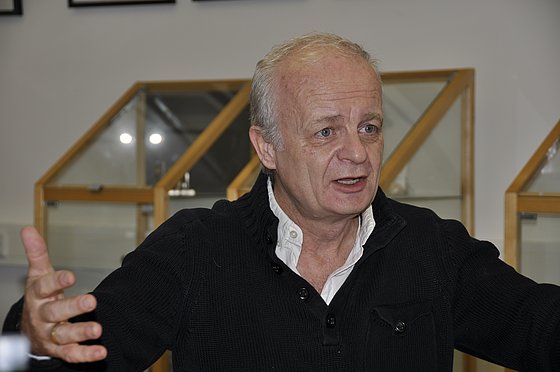
The archaeological museum in Amman
In the institute's Amman branch, employees are working on a cultural property protection project. Under Vieweger's supervision, a doctoral student from Wuppertal created a database that was recently introduced nationwide in Jordan. "First and foremost, it's about safeguarding antiquities," Vieweger says, "you saw it with the uprisings in Egypt or also in Iraq. A lot of archaeological property was stolen. Some of it was unique. Much was simply known a thousand times over and not at all expensive. But the black market fuels thefts and looted excavations. And this is devastating! And if something is 'hawked' on at the well-known auction houses, then the rightful owner must prove that the object belongs to him. So we mark, photograph, describe the contents of the large archive at the Amman Citadel Museum." It's a Sisyphean task for the scientists in Amman. "We have thousands of objects and register everything from cooking pots to gold coins - from a figurine to a jug deposited hundreds of times. The database works simultaneously in English and Arabic. We have high hopes of using it to prevent thefts - or at least bring back stolen property."
Treasures thought lost still slumber in the archives
In the process of processing and researching the museum's archives, documentation and objects thought to have disappeared are also resurfacing. "We also found limestone figurines of the kings of Amman from the 9th and 8th centuries BC. Some were on display - we didn't really know about the others. So we're digging up excavated ones."
With shovel and high-tech
Digging - that also means sweating. The image of the brush is deceptive. The wheelbarrow, the pickaxe and the trowel are the tools of choice - and the sweat of the brave is their reward. Manual labor and close observation: That's how archaeology will remain for a long time. But technology has arrived - geophysics - modern surveying - archaeo-botanical investigations - all this is now standard.
During his excavations, he now works paperless. All information immediately ends up in a database in Frankfurt/M, where the institute has rented a server. All data can be processed by ten different employees at the same time. "You find thousands of new objects every day," he says, "and then you need the meticulousness for every excavation you worked on for two months to evaluate it in the 10 months to come. But to do that, all the data has to be recorded correctly and stored in the database. That's what excites me! It's an exciting job and I can't think of a nicer one."
"Archaeology is a damn political thing" (William II).
Archaeology is a damn political thing," Kaiser Wilhelm II is said to have once said. With regard to the interpretation of the finds, Professor Vieweger certainly agrees with him. But the environment is not easy to understand either. The political conflict has become a constant companion. Vieweger's book "Streit um das Heilige Land - Was jeder vom israelisch-palästinensischen Konflikt wissen muss" has just entered its 7th edition.
Uwe Blass (interview of 05.12.2019)
Prof. Dr. Dr. h.c.. Dieter Vieweger is Professor of Old Testament and Biblical Archaeology at the Kirchliche Hochschule Wuppertal/Bethel, Visiting Professor of Archaeology at the Private University of Witten-Herdecke, Executive Director of the two institutes of the German Protestant Institute for Ancient Studies of the Holy Land in Jerusalem and Amman, representative of the Provost in Jerusalem and coordinator of Protestant educational work in the Holy City, and Director of the Biblical Archaeological Institute of the University of Wuppertal.
